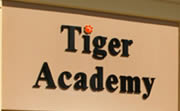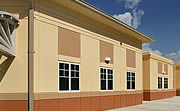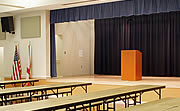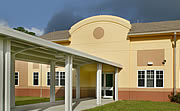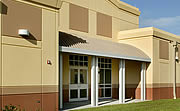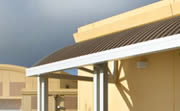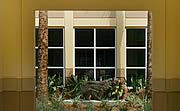Tiger Academy
Overview
The project consists of a 306-student Charter Elementary School, Pre-K through 5th Grade. The 6.6 acre site includes two single-story facilities. The main building includes classrooms, administration, media center and public conference room; the second building houses the cafeteria/multi-purpose room with a small stage and warming kitchen, and is connected to the main building with a covered walkway.
Panel Design - Classroom Wings
The exterior envelope utilizes a variety of architectural treatments that reduce the building's mass in order to respond to owner's concerns keeping the building scale appropriate to the size and scale of neighborhood homes, and making a less imposing structure for the children who use the facility. Panels on classroom wings utilize 30 degree return legs at panels and vary the parapet height between protruding and recessed panels. A three-color scheme provides building articulation. The darkest color, terra-cotta, serves as a building base like a brick-colored wainscoting; an intermediate dark beige color, serves as a transition from the darkest base to lighter yellow wall color, and as 'panels' within yellow fields of color to provide articulation and visual interest. Recessed panels are darker than foreground panels to accentuate the depth of building facades. A cap is placed at the top of protruding panels to further emphasize variety and depth. Each of these gestures contribute to a design solution that appropriately scales the building to its neighborhood and school use.
Panel Design Integrates with Other External Elements
The building design seamlessly integrates tilt-up with non-tilt-up elements to provide an integrated design solution. Curved parapets coordinate with curved metal canopies; the Mansard roof articulates the 'center' of the building, with flat roof wings; the tilt-up 'pavilion' at the point of arrival utilizes a metal roof like the canopies. This result provides variety and scale to the building so it is less monolithic in nature (and reduced cost to meet the budget needs). Additionally, the cafeteria/multi-purpose building is housed in a separate building at the rear and employs and integrates with canopies and the main building's rear elevation thereby further reducing neighborhood impact and integrating the facility design. These gestures, in combination with the color selection and massing, provide a playful, varied, nicely scaled building where tilt-up and non-tilt-up exterior elements work together to meet educational, budget, schedule, and design objectives.
Tilt-Up Supports Neighborhood Integration
The YMCA sponsored Charter School is a tremendous community asset and resource, to be utilized not only for elementary education, but in service of community groups. In partnership with other local agencies, the academy will also offer community services such as: Computer-based GED programs for ages 16 and up; Employment skills training; Senior assistance programs; Mental health counseling and support groups; Quality child care services; Financial literacy programs; Health screenings and services; Violence prevention and crisis intervention; Housing assistance and more. Located in a lower income/somewhat depressed area of town, the building design supports the community engagement and mission envisioned by the school's founders. The front canopy with integrated tilt-up pavilion, and small 'oasis' courtyard creates an unusual entrance and provides a welcoming environment for all building users. Immediately upon entry, is a community conference room, that looks into the courtyard through large opening in tilt-up panels, and supports the idea of welcomeness and community participation.
Features
An entry pavilion is created utilizing tilt-up, framing a small entry 'oasis' courtyard, which serves as a ceremonial point of arrival and location for school identification sign "Tiger Academy".
Curved parapets at the separate cafeteria/assembly building coordinates with the school's rear entrance, also with curved parapets and connecting metal canopy which also has a curved top.
Tilt-up panels utilize three colors to provide building articulation. The darkest, a terra-cotta color, serves as a building base like a brick-colored wainscoting. An intermediate dark beige color, serves as a transition from the darkest base to lighter yellow wall color, as 'panels' with yellow fields of color to provide articulation and visual interest, and the recessed areas along elevations to accentuate the depth of building facades. Return legs are used on panels as single panels or in pairs with an applied cap end raised parapet which 'standout' against the darker recessed areas. The effect is well-organized, nicely-scaled building elevations consistent with the desired effect of integrating with the scale of neighborhood buildings.
Recognition
The facility is designed as a community resource, integrated into the neighborhood, and includes a community conference space at the building's main entrance. As a school and community resource, the facility provides the services in an area of town which is often overlooked, depressed, and underserved, heightening the project's importance to the community.
The YMCA of Florida's First Coast, owner of this charter school, will place emphasis on reading achievement, student growth and behavior management, with strong parental involvement. In partnership with other local agencies, the academy will also offer community services such as: Computer-based GED programs for ages 16 and up; Employment skills training; Senior assistance programs; Mental health counseling and support groups; Quality child care services; Financial literacy programs; Health screenings and services; Violence prevention and crisis intervention; Housing assistance and more, a critical and much needed resource in this area of town!
Additional information
The project is economical in order to be able to meet it's educational objectives, therefore relying on subtle design manipulation of the tilt-up and other building components to create a quality educational environment. Tilt-up helps allow important educational objectives to be met. The facility's design supports the idea of community integration, allowed the team to meet an aggressive schedule and open on time for the 2009-2010 school-year, provided economy with durability necessary for school design and construction.
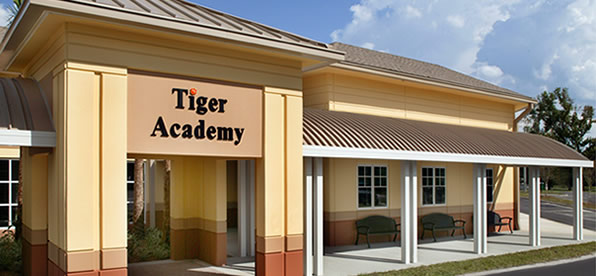
Project Location
Jacksonville, FL 32209
United States
Project Images
Project Team (TCA Members)
- General Contractor:
- Concrete Contractor:
- Architect:
- The Haskell Company
- Engineer:
- Photographer(s):
Project Specifics
- Project Category:
- Building Types:
- Finishes:
- Features:
- Insulation:
- Environmental:
- Number of Floors:
- 0
- Number of Panels:
- 106 panels
- Tilt-Up Wall Area:
- 36,256 sq ft (3,368 sq m)
- Total Floor Area:
- 32,581 sq ft (3,027 sq m)
- Project Footprint:
- 32,581 sq ft (3,027 sq m)
- Tallest Panel:
- 26 ft 9 in (8.15 m)
- Widest Panel:
- 30 ft 6 in (9.30 m)
- Largest Panel:
- 825 sq ft (76.6 sq m)
- Heaviest Panel:
- 74,750 lbs (33,906 kg)
